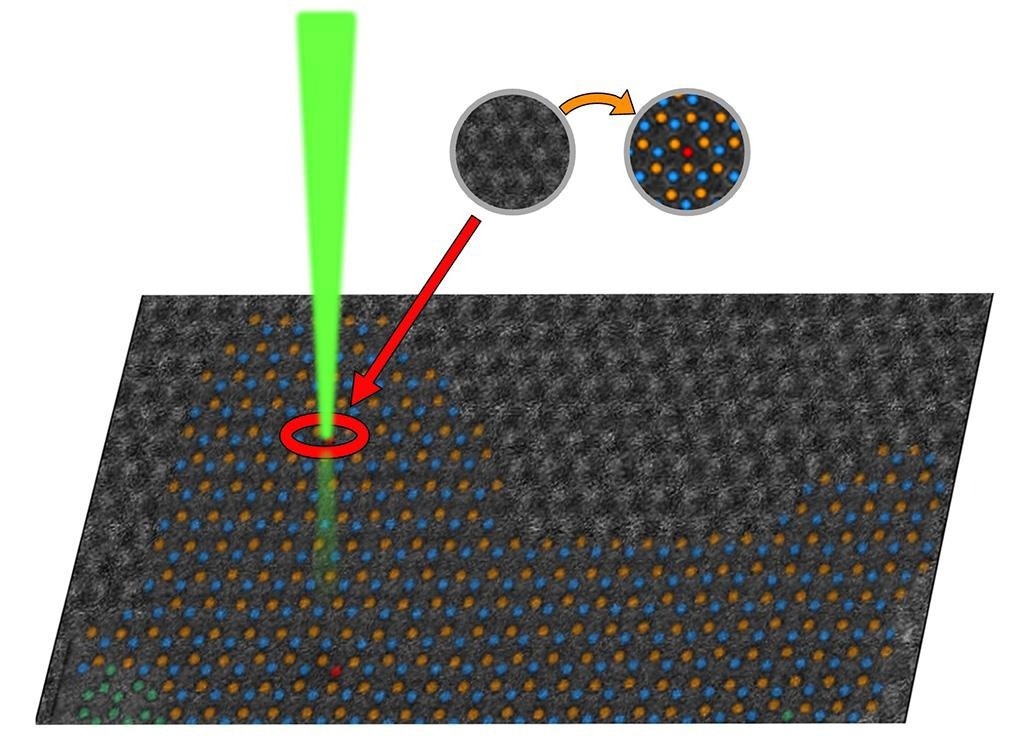In a study published in Science Advances, a research team headed by the Department of Energy’s Oak Ridge National Laboratory has developed an innovative technique to examine atomic-level material changes. The method creates new opportunities for creating and understanding advanced materials for electronics and quantum computing.

Electron microscopy measurements are usually performed by collecting all points in a 2D grid. Here, using deep learning in real time, only sites of interest are measured (colored circles), allowing experiments to be conducted on a much larger variety of materials, even those that change under the beam. Image Credit: Kevin Roccapriore and Scott Gibson/ORNL, US Dept. of Energy
By combining imaging, spectroscopy, and microscopy techniques, the new method—known as the Rapid Object Detection and Action System (RODAS)—captures the properties of transient atomic structures as they form, offering previously unheard-of insights into how material properties change at the smallest scales.
Conventional methods that combine electron energy loss spectroscopy (EELS) and scanning transmission electron microscopy (STEM) have been limited because the electron beam can alter or degrade the materials under study.
Due to this dynamic, scientists frequently measure changed states instead of the intended material properties. RODAS overcomes this restriction and incorporates the system with computer-vision-enabled imaging utilizing real-time machine learning.
RODAS examines only regions of interest when examining the specimen. In contrast to other STEM-EELS methods, which can sometimes take several minutes, this method allows for rapid analysis in seconds or milliseconds. Crucially, RODAS preserves the sample while extracting important information.
Every material has flaws, which can directly affect almost any of its characteristics, including its mechanical, electronic, and quantum characteristics. At the atomic level, defects can organize themselves in many ways, both naturally occurring and in reaction to outside stimuli like exposure to electron beam radiation.
Unfortunately, little is known about the local characteristics of these different defect configurations. STEM techniques can measure such configurations experimentally, but it is extremely hard to study particular configurations without changing them.
Understanding defect configurations is crucial for developing next-generation materials. If empowered with that knowledge, we could intentionally create a specific configuration to produce a specific property. Such work is entirely separate from the observation and analysis activity but represents one potentially impactful direction for the future.
Kevin Roccapriore, Study Lead Author and Center for Nanophase Materials Sciences, Oak Ridge National Laboratory
Unleashing Quantum Materials’ Potential
The research team showcased their methodology using single-layer molybdenum disulfide, a promising semiconductor material for quantum computing and optics applications. Molybdenum disulfide's ability to emit single photons from defects called single sulfur vacancies makes it particularly compelling.
The absence of one sulfur atom from the material's honeycombed lattice structure is referred to as a single sulfur vacancy. Since these vacancies can combine to form special electronic characteristics, molybdenum disulfide is useful for cutting-edge technological applications.
Scientists aim to research molybdenum disulfide and related single-layer materials to find important answers regarding optical or electronic properties at the atomic scale.
New Frontier in Materials Science
The RODAS technique is an important advancement in materials characterization. It enables researchers to measure specific atoms or defects as they form, dynamically explore structure-property relationships during analysis, efficiently gather data on different types of defects, adjust to identify new atomic or defect classes in real time, minimize sample damage while maintaining detailed analysis, and more.
By using this technology on a single layer of vanadium-doped molybdenum disulfide, the researchers gained a better understanding of defect formation and evolution under electron beam exposure. This approach enables the exploration and characterization of materials in dynamic states, providing a more in-depth understanding of how materials behave under various stimuli.
Materials science techniques such as advanced electron microscopy continue to expand our comprehension of the physical world, and systems such as RODAS could play a crucial role in accelerating discovery and innovation. The ability to observe and analyze materials at the atomic scale in real time shows potential for pushing the boundaries in computing, electronics and beyond, and ultimately enabling the development of transformative technologies.
Kevin Roccapriore, Study Lead Author and Center for Nanophase Materials Sciences, Oak Ridge National Laboratory
The study was sponsored by ORNL's Laboratory Directed Research and Development program as part of the Interconnected Science Ecosystem, or INTERSECT, initiative. STEM experiments were facilitated by the DOE Office of Science Basic Energy Sciences, Materials Sciences, and Engineering Division and carried out at ORNL’s Center for Nanophase Materials Sciences, a DOE Office of Science user facility.
The University of Washington’s Center for the Science of Synthesis Across Scales, an Energy Frontier Research Center funded by the DOE Office of Science Basic Energy Sciences, provided support for this study.
Journal Reference:
Roccapriore, K. M. et. al. (2024) Dynamic STEM-EELS for single-atom and defect measurement during electron beam transformations. Science Advances. doi.org/10.1126/sciadv.adn5899